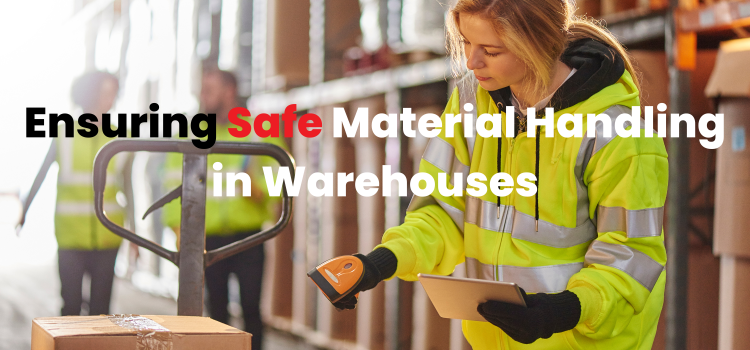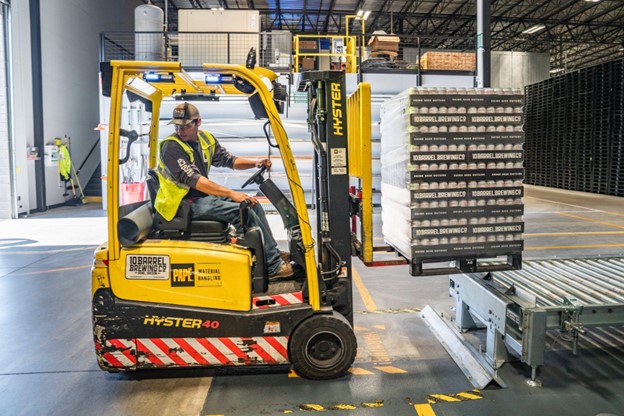Ensuring the safe material handling of these materials is not just a matter of policy or regulation; it’s the linchpin of efficient warehouse operations and by extension, effective Supply Chain Management.
The Importance of Material Handling in Warehouses
Material handling is one of the most important warehouse activities. It involves the movement, storage, control, and protection of goods throughout the process of manufacturing, distribution, consumption, and disposal. It’s a symphony of actions that can range from the simple physical movement of boxes to the complex orchestration of automated storage and retrieval systems.
Different types of materials handled in warehouses add layers to this complexity. From bulk goods like grains to break-bulk items such as electronic appliances, or unit loads like packed goods on pallets, warehouses handle a diverse range of materials. Each type comes with its unique handling requirements, and safety is paramount in every instance.
However, the task of material handling isn’t devoid of risks. Careless handling can lead to accidents, product damage, or even harm to personnel. Furthermore, accidents and inefficiencies in material handling can create ripples throughout the supply chain.
Let’s take a hypothetical example. A mishandled pallet in a warehouse could lead to damaged goods. This damage might not just mean financial loss but could also cause a delay in delivery, affecting customer satisfaction and overall business reputation.
Principles of Safe Material Handling
In an intricate world of warehouse operations, safe material handling forms the backbone of ensuring efficient processes and protecting personnel. This safety is guided by several principles that warehouses worldwide adhere to, drawing from the guidelines provided by authorities like the Occupational Safety and Health Administration (OSHA).
OSHA’s guidelines for safe material handling are comprehensive, encompassing everything from the correct lifting techniques to ensuring safe passageways for the movement of goods. Adhering to these guidelines can drastically reduce the risk of accidents and enhance overall operational efficiency.
On the other hand, ergonomics plays a significant role in material handling safety. Properly designed workspaces, which consider human abilities and limitations, can lessen the strain on the workers, thus reducing the risk of injuries. Imagine a worker bending awkwardly to lift a heavy box from the ground – it’s an accident waiting to happen. Now consider the same worker lifting a box from an elevated platform at waist height – it’s safer, more comfortable, and more efficient. That’s the essence of ergonomics.
Lastly, but equally importantly, training and awareness are the gatekeepers of safety. Workers who are well-trained in handling equipment and goods, aware of potential risks, and know the safety procedures, are less likely to be involved in accidents. Regular safety drills, training sessions, and a culture that values safety above everything else are instrumental in making warehouses safer.
[Read more: Top Warehouse Safety Checklist – 14 Categories to be Risk-Free]
Implementing Safe Material Handling Practices in Warehouses
Successfully implementing safe material handling practices in a warehouse is a multi-pronged process. It involves a strategic mix of equipment use, procedural guidelines, thoughtful layout design, and rigorous maintenance schedules.
Utilization of Proper Equipment
Equipment plays a pivotal role in warehouse operations, especially in material handling. From forklifts adept at handling heavy loads to conveyor belts streamlining the movement of goods, each equipment piece has its unique safety implications. For example, when using a forklift, it’s crucial to ensure that the load is secure before moving and that the pathway is clear to avoid accidents.
In many warehouses, high-elevation storage spaces or mezzanines are common. These spaces, while efficient for storage, can pose a significant safety risk. A common safety measure to mitigate this risk is the use of a sliding horizontal mezzanine safety gate. It offers protection during the loading and unloading process by ensuring that one side of the mezzanine is always protected. Such safety measures significantly reduce the risk of falls, keeping both workers and materials safe.
Further, the use of Personal Protective Equipment, or PPE is a fundamental part of safe material handling. Workers engaged in these tasks are often exposed to risks such as falling objects, sharp edges, splinters, and heavy loads. This is where PPE comes into play, acting as a critical barrier between the worker and potential hazards.
The specific types of PPE required can vary depending on the nature of the materials being handled and the specific tasks being performed. Commonly used items include:
● Safety Gloves: Protect hands from cuts, splinters, or punctures when handling materials. Specialized gloves may be necessary for handling hazardous materials or hot objects.
● Hard Hats: Shield the wearer from the risk of falling objects, especially crucial when workers are operating beneath elevated workspaces or heavy equipment.
● Steel-toed Boots: Protect feet from heavy falling objects and punctures, and often come with slip-resistant soles to prevent falls on slick surfaces.
● Safety Goggles: Shield the eyes from dust, flying particles, and chemical splashes. They are especially important when workers are handling sharp materials or hazardous substances.
● High-visibility Clothing: Enhances the visibility of the worker, especially in areas with heavy machinery or vehicle movement.
Adoption of Standard Operating Procedures
Procedures form the rulebook for safe material handling. They outline the correct techniques to handle different types of materials and instructions to operate equipment safely. It’s essential that these procedures are easily understandable, accessible to all workers, and strictly enforced.
Warehouse Layout
The design of the warehouse can significantly impact the safety of material handling. A well-thought-out layout ensures efficient traffic flow, minimizes the chances of collision, and creates adequate space for the storage and movement of goods. Safety considerations should be integral to the design process, from clearly marked pedestrian walkways to strategically placed fire exits.
Regular Maintenance and Safety Audits
Equipment maintenance is crucial to ensure the safe operation of material handling devices. Regular check-ups and timely repairs can prevent malfunctions that might lead to accidents. In the same vein, safety audits allow for the regular assessment of the warehouse’s safety standards, ensuring that all guidelines are being followed and any potential safety risks are identified and mitigated promptly.
Download Warehouse Safety Audit Tool
For warehouse working environments, the 14 Categories to Consider include:
- Warehouse General Safety and Materials Handling
- Forklift Operator Safety Checklist
- Warehouse Forklift Safety
- Back Safety & Lifting
- Loading Dock Safety
- Floor/ Walking and Working Surfaces
- Warehouse Racking And Storage / Pallets/Racks/Storage Practices
- Fire Equipment/Exits
- Fire Hazards
- Hazardous Materials/ Hazard Communication/Chemical Safety
- Ladders
- Electrical Safety
- Compressed Gas Cylinders
- Warehouse – COVID-19
Prioritizing Communication
Open, consistent, and clear communication is an often-overlooked aspect of warehouse safety. Communication not only relays vital information but also promotes a culture of safety by keeping all team members informed, engaged, and proactive about potential hazards.
● Regular Safety Meetings: Regular meetings allow the team to discuss safety-related concerns, provide feedback, and brainstorm solutions. This can enhance the overall safety culture and keep safety top-of-mind for all team members.
● Clear and Accessible Safety Guidelines: All safety procedures and guidelines should be easily accessible and clearly articulated. Visual aids and signage can be used to reinforce these guidelines.
● Effective Channels for Reporting Concerns: Workers must feel comfortable reporting safety concerns or potential hazards. Establishing an open-door policy or anonymous reporting mechanisms can encourage this.
● Quick Response Systems: Implementing effective channels for quick communication in case of emergencies can save crucial minutes and prevent accidents from escalating.
Leveraging the Power of Technology
As we navigate the 21st century, technology is becoming increasingly prevalent in all aspects of our lives, and warehouses are no exception. Modern warehousing relies on the power of automation and emerging technologies to enhance safety in material handling.
Embracing Automation in Material Handling
Automation in material handling can range from semi-automated equipment like guided forklifts to fully automated storage and retrieval systems. These technologies can significantly reduce the physical strain on workers and minimize human error, thereby reducing the risk of accidents.
However, the transition to automation isn’t without its challenges. It requires significant investment, changes in operational procedures, and sometimes, workforce retraining.
Nevertheless, the long-term safety and efficiency benefits make a compelling case for embracing automation.
The Role of the Internet of Things and Robotics
As technology advances, new tools are emerging that can further enhance warehouse safety. The Internet of Things (IoT) is a prime example. IoT devices can monitor equipment health in real-time, enabling proactive maintenance and reducing the risk of equipment failure. Similarly, wearable technologies can monitor workers’ health parameters, alerting them when they are overexerting or working in unsafe conditions.
Robotics is another burgeoning field. Robots can perform repetitive or risky tasks, reducing workers’ exposure to potential hazards. For instance, robotic arms can handle heavy loads or perform high-risk operations, such as handling hazardous materials.
Maximizing the Value of Data and Analytics
Big data and analytics are playing an increasingly important role in warehouse safety. By analyzing data from various sources – such as equipment sensors, worker wearables, and incident reports – warehouses can identify safety hotspots, predict potential risks, and devise preventive strategies.
Take our course on Modern Warehousing & Distribution Centers.
Conclusion
Safe material handling is central to efficient warehouse operations and Supply Chain Management. It’s a blend of proper equipment use, comprehensive procedures, ergonomic layout, regular audits, and the strategic use of technology.
However, the success of these elements is anchored on a workforce committed to safety. Although each warehouse is unique, a culture that values safety, coupled with continuous improvements and the adoption of suitable technology, can create safer work environments and foster efficient, resilient supply chains.





